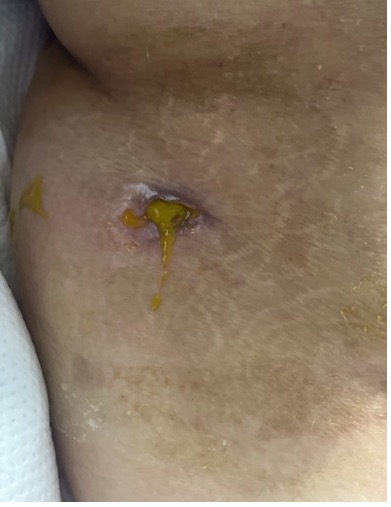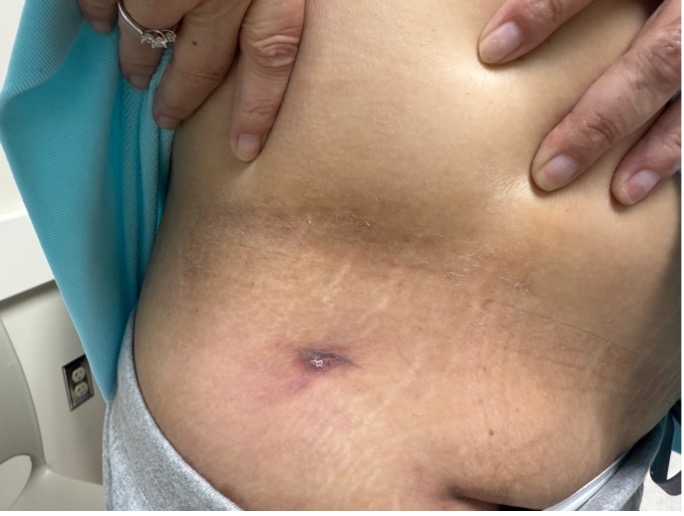Tuesday Poster Session
Category: Biliary/Pancreas
P4467 - A Hidden Exit: Cholecystocutaneous Fistula Following Biliary Intervention in Metastatic Pancreatic Cancer
Tuesday, October 28, 2025
10:30 AM - 4:00 PM PDT
Location: Exhibit Hall

Joshua Musalia, MD (he/him/his)
University of Cincinnati College of Medicine
Cincinnati, OH
Presenting Author(s)
Joshua Musalia, MD, Jacob Circillo, MD, Andrew Ofosu, MD, MPH
University of Cincinnati College of Medicine, Cincinnati, OH
Introduction: Cystic duct fistulas are rare, often underrecognized complications that can occur after biliary interventions such as cholecystectomy, ERCP, and percutaneous drainage. These abnormal connections may form between the biliary system and the gastrointestinal tract or skin. We report a case of a cholecystocutaneous fistula in a patient with metastatic pancreatic adenocarcinoma who developed a bile leak after partial cholecystectomy.
Case Description/
Methods: A 63-year-old woman with metastatic pancreatic cancer presented with altered mental status. Five months earlier, she had undergone partial cholecystectomy and an aborted Whipple procedure due to intraoperative discovery of liver metastases. Postoperatively, a cystic duct stump leak was identified on day 5 via HIDA scan. ERCP revealed contrast extravasation from the gallbladder remnant, and a double pigtail stent was placed through an existing uncovered metallic biliary stent. IR subsequently placed percutaneous drains to manage fluid collections, which were later removed following resolution.
At presentation, the patient was febrile and tachycardic. Labs revealed leukocytosis, elevated lactate, and polymicrobial bacteremia. She was transferred to our facility for further care. On examination, greenish-yellow purulent drainage was noted at the previous percutaneous drain site, raising concern for a cutaneous biliary fistula. Gastroenterology was consulted. ERCP on hospital day 3 demonstrated contrast extravasation from the cystic duct remnant into the abdominal wall, consistent with a cholecystocutaneous fistula. Tumor ingrowth was also seen in the existing biliary stent.
A covered 10 Fr × 8 cm metallic stent was placed through the uncovered stent to seal the cystic duct origin. The patient improved clinically and was discharged on oral ciprofloxacin and metronidazole. At one-month follow-up, the fistula had resolved with no further drainage.
Discussion: Cystic duct fistulas are rare complications, typically arising in the setting of bile leaks, malignancy, or infection. This patient’s risk was compounded by partial cholecystectomy and metastatic disease. Endoscopic therapy, particularly covered SEMS placement, is a key strategy for managing biliary fistulas in non-surgical candidates. This case highlights the value of a multidisciplinary approach in treating complex biliary pathology in high-risk patients.

Figure: Purulent drainage from site of previous percutaneous tube, suspected to be bilious in nature

Figure: Healed cholocutaneous fistulous tract at follow-up visit
Disclosures:
Joshua Musalia indicated no relevant financial relationships.
Jacob Circillo indicated no relevant financial relationships.
Andrew Ofosu indicated no relevant financial relationships.
Joshua Musalia, MD, Jacob Circillo, MD, Andrew Ofosu, MD, MPH. P4467 - A Hidden Exit: Cholecystocutaneous Fistula Following Biliary Intervention in Metastatic Pancreatic Cancer, ACG 2025 Annual Scientific Meeting Abstracts. Phoenix, AZ: American College of Gastroenterology.
University of Cincinnati College of Medicine, Cincinnati, OH
Introduction: Cystic duct fistulas are rare, often underrecognized complications that can occur after biliary interventions such as cholecystectomy, ERCP, and percutaneous drainage. These abnormal connections may form between the biliary system and the gastrointestinal tract or skin. We report a case of a cholecystocutaneous fistula in a patient with metastatic pancreatic adenocarcinoma who developed a bile leak after partial cholecystectomy.
Case Description/
Methods: A 63-year-old woman with metastatic pancreatic cancer presented with altered mental status. Five months earlier, she had undergone partial cholecystectomy and an aborted Whipple procedure due to intraoperative discovery of liver metastases. Postoperatively, a cystic duct stump leak was identified on day 5 via HIDA scan. ERCP revealed contrast extravasation from the gallbladder remnant, and a double pigtail stent was placed through an existing uncovered metallic biliary stent. IR subsequently placed percutaneous drains to manage fluid collections, which were later removed following resolution.
At presentation, the patient was febrile and tachycardic. Labs revealed leukocytosis, elevated lactate, and polymicrobial bacteremia. She was transferred to our facility for further care. On examination, greenish-yellow purulent drainage was noted at the previous percutaneous drain site, raising concern for a cutaneous biliary fistula. Gastroenterology was consulted. ERCP on hospital day 3 demonstrated contrast extravasation from the cystic duct remnant into the abdominal wall, consistent with a cholecystocutaneous fistula. Tumor ingrowth was also seen in the existing biliary stent.
A covered 10 Fr × 8 cm metallic stent was placed through the uncovered stent to seal the cystic duct origin. The patient improved clinically and was discharged on oral ciprofloxacin and metronidazole. At one-month follow-up, the fistula had resolved with no further drainage.
Discussion: Cystic duct fistulas are rare complications, typically arising in the setting of bile leaks, malignancy, or infection. This patient’s risk was compounded by partial cholecystectomy and metastatic disease. Endoscopic therapy, particularly covered SEMS placement, is a key strategy for managing biliary fistulas in non-surgical candidates. This case highlights the value of a multidisciplinary approach in treating complex biliary pathology in high-risk patients.

Figure: Purulent drainage from site of previous percutaneous tube, suspected to be bilious in nature

Figure: Healed cholocutaneous fistulous tract at follow-up visit
Disclosures:
Joshua Musalia indicated no relevant financial relationships.
Jacob Circillo indicated no relevant financial relationships.
Andrew Ofosu indicated no relevant financial relationships.
Joshua Musalia, MD, Jacob Circillo, MD, Andrew Ofosu, MD, MPH. P4467 - A Hidden Exit: Cholecystocutaneous Fistula Following Biliary Intervention in Metastatic Pancreatic Cancer, ACG 2025 Annual Scientific Meeting Abstracts. Phoenix, AZ: American College of Gastroenterology.
